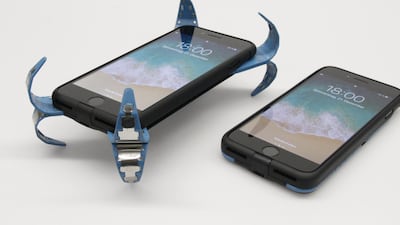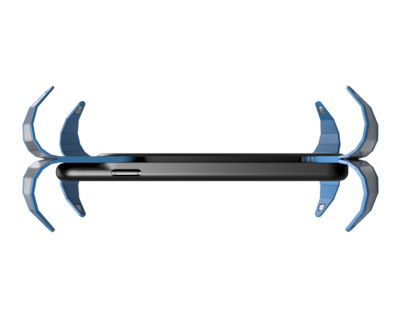As a species, we’ve become prone to breaking our phones by dropping them on the ground. A global survey conducted by Motorola in 2015 found that 50% of us have cracked a smartphone screen at some point, and a few studies suggest that around 20% of smartphones in use have a broken screen, whether that’s a single crack or a spider’s web-style smash. We might expect items that cost as much as 5,000 AED to have a little more resilience, but as one reviewer noted when considering the iPhone X: “Instead of gripping it, I'm more likely to cradle it so as not to hide the screen… I worry about dropping this phone. ” And drop them we do, in our millions, causing touch screens to malfunction, electronics to short circuit and splinters to cut our fingers.
A German student by the name of Philip Frenzel knows all about this, having dropped and shattered his brand new iPhone back in 2014. While most of us would try to claim on insurance or vow to buy a protective case, Frenzel decided to tackle the problem at source. After a few years of development, he has come up with a phone case that senses when it’s falling and shoots out eight shock absorbing “limbs” to cushion it as it hits the floor. He calls those limbs “Active Dampers”, and the product itself the “ADcase”. When the video of the prototype was uploaded to YouTube a couple of weeks ago, the reaction was immediate. “We got so much positive feedback and support from all over the world,” says Frenzel. “Companies have approached us regarding cooperation, and some investors have already contacted us.” But the bigger question is why, more than 10 years after the launch of the first smartphone, has it taken a German engineering student to save us from our own clumsiness?
We buy ergonomically designed phones - and then wrap them in chunky cases
The reason that the major smartphone manufacturers haven’t yet produced an unbreakable smartphone is simple: aesthetics. Glass makes for a beautiful display, while plastic doesn’t. Slim devices provoke gasps of admiration, but chunky ones don’t. In essence, the smartphone’s fragility is down to the sleekness of its design. In recent years, the trend has been for the bezel (i.e. the non-screen portion of the front of a smartphone) to get smaller and the screen to get larger, which has only made matters worse. (The irony, of course, is that smartphone vendors urge us to buy bulky cases and screen protectors which conceal the sylph-like stylings of the more expensive devices.)
______________________
More from Rhodri:
How measuring apps became a reality
From Amazon to Google: Why we need to pay attention to these tech giants
Battle Royale: the story behind the phenomenon that is Fortnite
The risks that face crowdfunded campaigns
______________________
Glass is the smartphone’s main weakness: flaws in its surface, when subjected to stress, lead to cracks. This applies to all kinds of glass, but there’s a constant quest to make screens more durable; Gorilla Glass, made by US company Corning, is currently used in the majority of high-end smartphones and its latest iteration is supposed to survive a drop of around 1.6 metres. “Each generation of our glass has gotten tougher and more damage resistant,” says a Corning spokesperson. “[But] while devices with Gorilla Glass… are better able to survive the daily wear-and-tear devices endure, no glass is unbreakable.”
Little wonder that around 800 million smartphone cases and another 800 million screen protectors were sold globally last year. With the majority of broken screens being caused by impact to the corners and edges of a phone, a case offers more protection than a screen protector – but as Frenzel found, they don’t always provide the reassurance we’re looking for. (“The protection was not satisfying at all,” he says of his own experience.) But as the sensors within mobile phones become more adept at detecting movement, it’s possible to envisage a case that could deploy some kind of cushion when gravity wreaks its havoc. “The first ideas were totally different and not comparable to the ADcase of today,” says Frenzel. “You need to overcome several challenges… details are much more demanding than general idea and function issues.”
Smartphone airbags?
The general idea Frankel speaks of isn’t new. In February 2010, Amazon filed a patent for a case which reacted to a tumbling phone by shooting out small airbags, springs or airstreams, and it was granted that patent at the end of 2012. But aside from the 2013 production of a bulky smartphone airbag by Honda (which was, most likely, a tongue-in-cheek advert for one of its in-car airbags) nothing further was heard of this idea until Frankel’s video appeared last month. Cynics might suggest that the big smartphone manufacturers have little to gain by developing protective cases; iPhone owners are reported to have spent $14 billion on repairs in the last decade, a significant proportion of which will have been paid directly to Apple. As the CEO of US mobile repair service iDropped stated in 2016: “The bread-and-butter of the mobile-device repair industry is screen replacement.”
But the search is very much on for a screen that is both elegant and unbreakable. After all, if we’re convinced that a phone is durable, we’ll be willing to pay even more for it. One avenue currently being pursued is the self-healing screen, a polymer that mends itself whenever scratches or cracks occur. Such a material was used for the back of LG’s G Flex phone back in 2013, but it’s the weak spot – the screen – that would benefit more significantly from such technology. Last year Motorola filed a patent for a screen that could detect and repair itself using carefully directed heat, and recent work on self-healing plastics at the University of Tokyo and China’s Harbin Institute of Technology suggests that science may soon be able to assist with that leap from patent to product.
Back in the here and now, Frenzel's ADcase is due to launch on Kickstarter later this month. Until that happens, we will continue to be at the mercy of our fragile smartphones, dropping them, sighing, and using ineffective home remedies such as toothpaste or baking soda to hide those shameful cracks from public view. Roll on progress.


